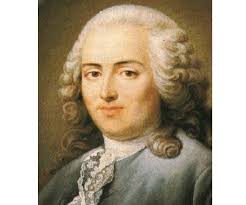We Need Their Voices Today! (7) The Marquis de Condorcet
TRANSCEND MEMBERS, 7 Aug 2017
John Scales Avery, Ph.D. – TRANSCEND Media Service
Introduction
This is a collection of biographical sketches showing people whose wise voices from the past can help to guide us today. All of the women and men, brief glimpses of whose lives and ideas are portrayed here, gave a high place to compassion. None of them was a slave to greed. We need their voices today!
[Note from TMS editor: It will be posted one biographical sketch per week]
**********************************************
A Vision of Human Progress
In France the Marquis de Condorcet had written an equally optimistic book, “Esquisse d’un Tableau Historique des Progres de l’Esprit Humain”. Condorcet’s optimism was unaffected even by the fact that at the time when he was writing he was in hiding, under sentence of death by Robespierre’s government. Like Godwin’s “Political Justice”, this book offers an optimistic vision of of how human society can be improved. Together, the two books provoked Malthus to write his book on population.
Condorcet Becomes a Mathematician
Marie-Jean-Antoine-Nicolas Caritat, Marquis de Condorcet, was born in 1743 in the town of Ribemont in southern France. He was born into an ancient and noble family of the principality of Orange but there was nothing in his background to suggest that he might one day become a famous scientist and social philosopher. In fact, for several generations before, most of the men in the family had followed military or ecclesiastical careers and none were scholars.
After an initial education received at home from his mother, Condorcet was sent to his uncle, the Bishop of Lisieux, who provided a Jesuit tutor for the boy. In 1758 Condorcet continued his studies with the Jesuits at the College of Navarre. After he graduated from the College, Condorcet’s powerful and independent intelligence suddenly asserted itself. He announced that he intended to study mathematics. His family was unanimously and violently opposed to this idea. The privileges of the nobility were based on hereditary power and on a static society. Science, with its emphasis on individual talent and on progress, undermined both these principles. The opposition of Condorcet’s family is therefore understandable, but he persisted until they gave in.
From 1765 to 1774, Condorcet focused on science. In 1765, he published his first work on mathematics entitled “Essai sur le calcul integral” which was well received, launching his career as a mathematician. He would go on to publish many more papers, and in 1769, at the age of 26, he was elected to the Academie royale des Sciences (French Royal Academy of Sciences).
Condorcet worked with Leonhard Euler and Benjamin Franklin. He soon became an honorary member of many foreign academies and philosophic societies including the Royal Swedish Academy of Sciences (1785), Foreign Honorary Member of the American Academy of Arts and Sciences (1792), and also in Prussia and Russia.
Human Rights and Scientific Sociology
In 1774, at the age of 31, Condorcet was appointed inspector general of the Paris Mint by his friend, the economist Turgot. From this point on, Condorcet shifted his focus from the purely mathematical to philosophy and political matters. In the following years, he took up the defense of human rights in general, and of women’s and blacks’ rights in particular (an abolitionist, he became active in the Society of the Friends of the Blacks in the 1780s). He supported the ideals embodied by the newly formed United States, and proposed projects of political, administrative and economic reforms intended to transform France.
The year 1785 saw the publication of Condorcet’s highly original mathematical work, “Essai sur l’application de l’analyse \`a la probabilite des decisions rendues a la pluralite des voix”, in which he pioneered the application of the theory of probability in the social sciences. A later, much enlarged, edition of this book extended the applications to games of chance. Through these highly original works, Condorcet became a pioneer of scientific sociology.
In 1786, Condorcet married one of the most beautiful women of the time, Sophie de Grouchy (1764-1822). Condorcet’s position as Inspector-General of the Mint meant that they lived at the Hotel des Monnaies. Mme Condorcet’s salon there was famous.
The French Revolution
Ever since the age of 17, Condorcet had thought about questions of justice and virtue and especially about how it is in our own interest to be both just and virtuous. Very early in his life he had been occupied with the idea of human perfectibility. He was convinced that the primary duty of every person is to contribute as much as possible to the development of mankind, and that by making such a contribution, one can also achieve the greatest possible personal happiness. When the French Revolution broke out in 1789 he saw it as an unprecedented opportunity to do his part in the cause of progress and he entered the arena wholeheartedly.
Condorcet was first elected as a member of the Municipality of Paris; and then, in 1791, he became one of the six Commissioners of the Treasury. Soon afterwards he was elected to the Legislative Assembly, of which he became first the Secretary and finally the President. In 1792, Condorcet proposed to the Assembly that all patents of nobility should be burned. The motion was carried unanimously; and on 19 June his own documents were thrown on a fire with the others at the foot of a statue of Louis XIV.
Condorcet was one of the chief authors of the proclamation which declared France to be a republic and which summoned a National Convention. As he remained above the personal political quarrels that were raging at the time, Condorcet was elected to the National Convention by five different constituencies. When the Convention brought Louis XVI to trial, Condorcet maintained that, according to the constitution, the monarch was inviolable and that the Convention therefore had no legal right to try the King. When the King was tried despite these protests, Condorcet voted in favor of an appeal to the people.
Drafting a New Constitution for France
In October 1792, when the Convention set up a Committee of Nine to draft a new constitution for France, Condorcet sat on this committee as did the Englishman, Thomas Paine. Under sentence of death in England for publishing his pamphlet “The Rights of Man”, Paine had fled to France and had become a French citizen. He and Condorcet were the chief authors of a moderate (Gerondist) draft of the constitution. However, the Jacobin leader, Robespierre, bitterly resented being excluded from the Committee of Nine and, when the Convention then gave the responsibility for drafting the new constitution to the Committee for Public Safety, which was enlarged for this purpose by five additional members.
The result was a hastily produced document with many glaring defects. When it was presented to the Convention, however, it was accepted almost without discussion. This was too much for Condorcet to stomach and he published anonymously a letter entitled “Advice to the French on the New Constitution”, in which he exposed the defects of the Jacobin constitution and urged all Frenchmen to reject it.
Hiding from Robespierre’s Terror
Condorcet’s authorship of this letter was discovered and treated as an act of treason. On 8 July 1793, Condorcet was denounced in the Convention; and an order was sent out for his arrest. The officers tried to find him, first at his town house and then at his house in the country but, warned by a friend, Condorcet had gone into hiding.
The house where Condorcet took refuge was at Rue Servandoni, a small street in Paris leading down to the Luxembourg Gardens, and it was owned by Madame Vernet, the widow of a sculptor. Madame Vernet, who sometimes kept lodgings for students, had been asked by Condorcet’s friends whether she would be willing to shelter a proscribed man. “Is he a good man?”, she had asked; and when assured that this was the case, she had said, `Then let him come at once. You can tell me his name later. Don’t waste even a moment. While we are speaking, he may be arrested.’ She did not hesitate, although she knew that she risked death, the penalty imposed by the Convention for sheltering a proscribed man.
Condorcet Writes the “Esquisse”
Although Robespierre’s agents had been unable to arrest him, Condorcet was sentenced to the guillotine in absentia. He knew that in all probability he had only a few weeks or months to live and he began to write his last thoughts, racing against time. Hidden in the house at Rue Servandoni, and cared for by Madame Vernet, Condorcet returned to a project which he had begun in 1772, a history of the progress of human thought, stretching from the remote past to the distant future. Guessing that he would not have time to complete the full-scale work he had once planned, he began a sketch or outline: “Esquisse d’un Tableau Historique des progres de l’Esprit Humain” (“Historical Scetch of the Progress of the Human Spirit”).
Condorcet’s “Esquisse”, is an enthusiastic endorsement of the idea of infinite human perfectibility which was current among the philosophers of the 18th century, and in this book, Condorcet anticipated many of the evolutionary ideas of Charles Darwin. He compared humans with animals, and found many common traits. Condorcet believed that animals are able to think, and even to think rationally, although their thoughts are extremely simple compared with those of humans. He also asserted that humans historically began their existence on the same level as animals and gradually developed to their present state.
In his “Esquisse”, Condorcet called attention to the unusually long period of dependency which characterize the growth and education of human offspring. This prolonged childhood is unique among living beings. It is needed for the high level of mental development of the human species; but it requires a stable family structure to protect the young during their long upbringing. Thus, according to Condorcet, biological evolution brought into existence a moral precept, the sanctity of the family.
Similarly, Condorcet maintained, larger associations of humans would have been impossible without some degree of altruism and sensitivity to the suffering of others incorporated into human behavior, either as instincts or as moral precepts or both; and thus the evolution of organized society entailed the development of sensibility and morality.
Condorcet believed that ignorance and error are responsible for vice; and he listed what he regarded as the main mistakes of civilization: hereditary transmission of power, inequality between men and women, religious bigotry, disease, war, slavery, economic inequality, and the division of humanity into mutually exclusive linguistic groups.
Condorcet also believed the hereditary transmission of power to be the source of much of the tyranny under which humans suffer; and he looked forward to an era when republican governments would be established throughout the world. Turning to the inequality between men and women, Condorcet wrote that he could see no moral, physical or intellectual basis for it. He called for complete social, legal, and educational equality between the sexes.
Condorcet predicted that the progress of medical science would free humans from the worst ravages of disease. Furthermore, he maintained that since perfectibility (i.e. evolution) operates throughout the biological world, there is no reason why mankind’s physical structure might not gradually improve, with the result that human life in the remote future could be greatly prolonged. Condorcet believed that the intellectual and moral facilities of man are capable of continuous and steady improvement; and he thought that one of the most important results of this improvement will be the abolition of war.
At the end of his “Esquisse”, Condorcet said that any person who has contributed to the progress of mankind to the best of his ability becomes immune to personal disaster and suffering. He knows that human progress is inevitable and can take comfort and courage from his inner picture of the epic march of mankind, through history, towards a better future.
Condorcet Leaves His Hiding Place to Spare His Generous Hostess
Shortly after Condorcet completed the “Esquisse”, he received a mysterious warning that soldiers of the Convention were on their way to inspect Madame Vernet’s house. Wishing to spare his generous hostess from danger, he disguised himself as well as he could and slipped past the portress. However, Condorcet had only gone a few steps outside the house when he was recognized by Madame Verdet’s cousin, who risked his life to guide Condorcet past the sentinels at the gates of Paris, and into the open country beyond.
Condorcet wandered for several days without food or shelter, hiding himself in quarries and thickets. Finally, on 27 March 1794, hunger forced him to enter a tavern at the village of Clamart, where he ordered an omelette. When asked how many eggs it should contain, the exhausted and starving philosopher replied without thinking, “twelve”. This reply, together with his appearance, excited suspicion. He was asked for his papers and, when it was found that he had none, soldiers were sent for and he was arrested. He was taken to a prison at Bourg-la-Reine, but he was so weak that he was unable to walk there, and had to be carried in a cart.
The next morning, Condorcet was found dead on the floor of his cell. The cause of his death is not known with certainty. It was listed in official documents as congestion sanguine, congestion of the blood but the real cause may have been cold, hunger, exhaustion or poison. Many historians believe that Condorcet was murdered by Robespierre’s agents, since he was so popular that a public execution would have been impossible.
After Condorcet’s death the currents of revolutionary politics shifted direction. Robespierre, the leader of the Terror, was himself soon arrested. The execution of Robespierre took place on 25 July 1794, only a few months after the death of Condorcet.
Condorcet’s “Esquisse d’un Tableau Historique des Progres de l’Esprit Humain” was published posthumously in 1795. In the post-Thermidor reconstruction, the Convention voted funds to have it printed in a large edition and distributed throughout France, thus adopting the “Esquisse” as its official manifesto. Condorcet’s name will always be linked with this small prophetic book. It was destined to establish the form in which the eighteenth-century idea of progress was incorporated into Western thought, and (as we shall see) it provoked Robert Malthus to write “An Essay on the Principle of Population”.
Nicolas Caritat, Marquis de Condorcet, definer of the idea of progress, defender of human rights and the rights of all living things, we need your voice today!
Contents:
1 Saint Francis of Assisi
2 William Blake
3 Thomas Paine
4 Thomas Jefferson
5 Mary Wollstonecraft
6 William Godwin
7 The Marquis de Condorcet
8 Thomas Robert Malthus
9 Percy Bysshe Shelley
10 Robert Owen
11 John Stuart Mill
12 Henry David Thoreau
13 Count Leo Tolstoy
14 Mahatma Gandhi
15 Martin Luther King
16 Wilfred Owen
17 Albert Einstein
18 Edna St. Vincent Millay
19 Bertha von Suttner
20 George Orwell
21 Helen Keller
22 We need their voices, and yours!
________________________________________________
 John Scales Avery, Ph.D., who was part of a group that shared the 1995 Nobel Peace Prize for their work in organizing the Pugwash Conferences on Science and World Affairs, is a member of the TRANSCEND Network and Associate Professor Emeritus at the H.C. Ørsted Institute, University of Copenhagen, Denmark. He is chairman of both the Danish National Pugwash Group and the Danish Peace Academy and received his training in theoretical physics and theoretical chemistry at M.I.T., the University of Chicago and the University of London. He is the author of numerous books and articles both on scientific topics and on broader social questions. His most recent books are Information Theory and Evolution and Civilization’s Crisis in the 21st Century (pdf).
John Scales Avery, Ph.D., who was part of a group that shared the 1995 Nobel Peace Prize for their work in organizing the Pugwash Conferences on Science and World Affairs, is a member of the TRANSCEND Network and Associate Professor Emeritus at the H.C. Ørsted Institute, University of Copenhagen, Denmark. He is chairman of both the Danish National Pugwash Group and the Danish Peace Academy and received his training in theoretical physics and theoretical chemistry at M.I.T., the University of Chicago and the University of London. He is the author of numerous books and articles both on scientific topics and on broader social questions. His most recent books are Information Theory and Evolution and Civilization’s Crisis in the 21st Century (pdf).
This article originally appeared on Transcend Media Service (TMS) on 7 Aug 2017.
Anticopyright: Editorials and articles originated on TMS may be freely reprinted, disseminated, translated and used as background material, provided an acknowledgement and link to the source, TMS: We Need Their Voices Today! (7) The Marquis de Condorcet, is included. Thank you.
If you enjoyed this article, please donate to TMS to join the growing list of TMS Supporters.

This work is licensed under a CC BY-NC 4.0 License.

